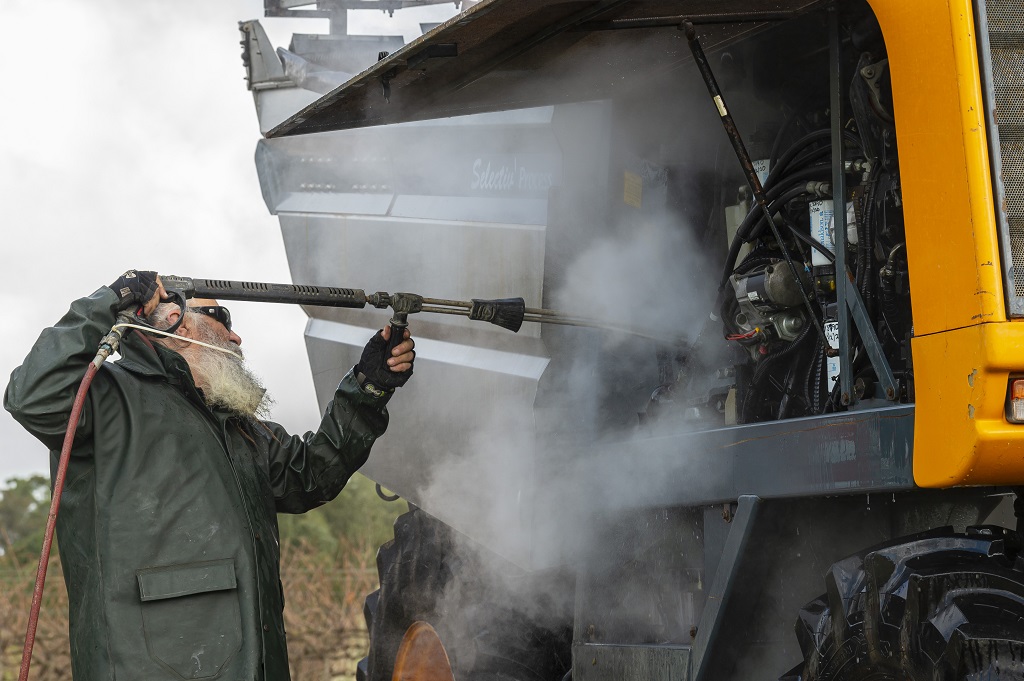The term ‘biosecurity bubble’ has often been used during the COVID-19 pandemic, with interstate sports hubs, medi-hotels and quarantine facilities all part of Australia’s COVID response.
Vinehealth Australia is encouraging the wine industry to adopt the biosecurity bubble philosophy learned during COVID, as Cindie Smart writes. What is it and how can it be applied?
Now Vinehealth Australia is encouraging the wine industry to adopt the philosophy when thinking about zones where common requirements for cleaning and disinfestation exist.
This is particularly important heading into vintage when heightened movement of machinery, equipment and people across states, regions and blocks occurs.
What is a wine industry biosecurity bubble?
Your biosecurity bubble might be your property, if you insist that all machinery and equipment is cleaned before entry, and that appropriate ‘safe’ footwear and clothing is always worn by people entering your vineyard.
Or, if you’re a larger company, your biosecurity bubble might be all of the vineyards you own in a region.
And for some parts of Australia, the biosecurity bubble might include the entire region, especially in instances where there are few vineyards and the sharing of machinery, equipment and people between them is commonplace.
“On some occasions your biosecurity bubble might be smaller than your property boundary and down to a block level if, for example, there is a particular block on your property that has a known virus or pest issue and any machinery and equipment used on that block needs to be properly cleaned before use elsewhere, to limit spread,” said Suzanne McLoughlin, Vinehealth Australia technical manager.
“It’s also important to note that biosecurity bubbles might change depending on the time of the year, or the type of pest you’re dealing with, the activity you’re performing, where the machinery or equipment has come from and the regulatory or quarantine zone you’re in.”
Come clean, leave clean
Once you’ve defined your biosecurity bubble, the key to good biosecurity management is to insist that all visitors to your vineyard – including their machinery, equipment, clothing and footwear – come clean and leave clean.
“Be clear about what cleaning and disinfestation activities you expect for machinery and equipment before it arrives on your property,” McLoughlin said.
“Also think about vehicles, clothes, footwear and small tools. Do you expect cleaning before arrival, between vines, between blocks, daily, and when the contractor leaves?
“And as a vineyard owner, also consider the facilities and volumes of water and solutions you are providing to enable suitable cleaning. If you’re not set up for this, now is the time to get organised.”
Planning is key
In the lead up to vintage, think about all of the people, machinery and equipment that will be coming onto your property and communicate with them about your biosecurity expectations.
“If you’re using an interstate contractor, for example, there is a set of import requirements for any regulated item being moved, such as machinery, that must be met,” McLoughlin said.
“Each state’s import regulations can be slightly different, so check with the receiving state’s agricultural department to ensure you know the rules relevant to that state.”
Before contractors or other visitors arrive, it’s also important to consider and confirm what evidence of cleaning and disinfestation you will require for non-regulated items such as footwear and clothing. “You might want to ask for photographic evidence, which is easy to take and email through and is time stamped,” McLoughlin said.
“You should also confirm the office location, the parking areas, the location of cleaning and disinfestation facilities and any off-limit areas.”
Contractor quotes
Vinehealth Australia also encourages vineyard owners and contractors to formalise biosecurity arrangements in their contracts and quotes.
“Clarity in wording can minimise assumptions on what activities will be undertaken, how they will be done, who will do what and what proof is required,” McLoughlin said.
“As well as the details about the cleaning practices, contractor quotes might include the time it will take to clean machinery prior to arrival in the biosecurity bubble, the time to clean prior to departure from the biosecurity bubble, and clarity on who’s responsible for the fees and charges associated with any required biosecurity documentation and inspections.”
What’s at stake?
Nationally, the wine industry contributes more than $40 billion to the Australian economy.
“We have a lot to lose if a significant pest or disease damages our wine industry. Biosecurity is a cornerstone to the viability of the Australian wine industry,” McLoughlin said.
The need for better biosecurity management is amplified when consideration is given to the connectivity of the wine industry across the entire supply chain.
“And we all know that sharing people, machinery and equipment increases the risk of pest introduction and spread, so good biosecurity practices need to be undertaken by everyone in the supply chain,” McLoughlin said.
McLoughlin said COVID-19 had given Australians a taste of what shut down can look like. “We’ve seen closed borders, limits on our movement and heightened regulations,” she said.
“Similarly, a significant outbreak in the wine industry would see shut down of sites, restrictions on movement and routes travelled, quarantining of machinery and equipment, additional regulations, loss of unique vine material and closure of businesses.
“It’s worth investing time now to get biosecurity practices right to protect our businesses and our industry.”
Vinehealth Australia has created, and is currently refining, a ‘Biosecurity for Contractors’ training program which provides more detail about these topics. There are plans for the program to be rolled out across South Australia in 2021.
This article was originally published in the January 2021 issue of the Australian & New Zealand Grapegrower & Winemaker. To find out more about our monthly magazine, or to subscribe, click here!
Are you a Daily Wine News subscriber? If not, click here to join our mailing list. It’s free!





















